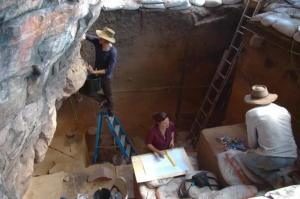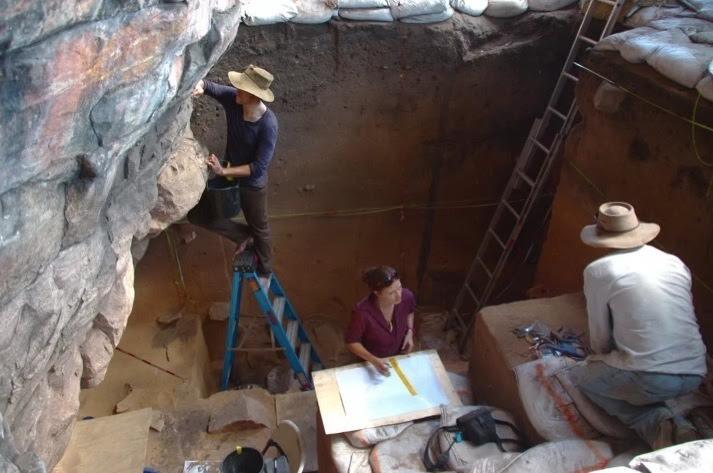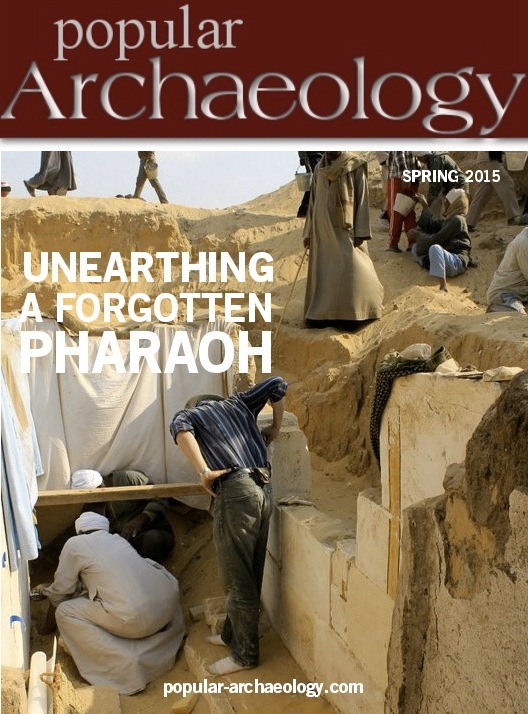
The site of Madjedbebe, a shallow rock shelter located in northern Australia, is known for yielding stone artifacts and faunal remains that archaeologists suggest date the presence of modern humans on the Australian continent at about 50,000 – 60,000 years ago. The site, however, has been at the center of a debate regarding the validity of the dating, as some scholars have cast doubt on the stratigraphic integrity and history of the deposits at the site as reported by investigations conducted in 1989 excavations.
Now, Chris Clarkson of the University of Queensland, Australia and colleagues report results of a new study on the stone tool artifacts and faunal remains found during the 1989 excavations.
“We demonstrate that the technology and raw materials of the early assemblage are distinctive from those in the overlying layers,” stated Clarkson, et al., in their report. “We conclude that previous claims of extensive displacement of artefacts and post-depositional disturbance may have been overstated. The stone artefacts and stratigraphic details support previous claims for human occupation 50–60 ka and show that human occupation during this time differed from later periods.”*
Madjedbebe has evidence of very early and later human occupation. Early investigations at the site uncovered wall paintings by the later human occupants, including charcoal dating to 18,000 years ago and other associated artifacts, such as a grinding hollow and 2 mortars, one of which had traces of ochre.
But later excavations indicated that Madjedbebe could be the oldest dated site in Australia. The first and earliest (by deposition) appeared about 2.6 m below the surface. These layers were dated to between 61,000 and 52,000 years old. From a depth of 2.5-2.3 m the scientists recorded relatively dense occupation, dated to between 52,000 +7,000/-11,000 BP and 45,000 +6,000/-9,000 BP. More than 1500 artifacts (designated as the Malakunanja assemblage) were in the lowest occupation layer.
_______________________________________
 Excavations at Madjedbebe in 2012. From A History of Australia’s Prehistory, lecture before the Royal Australian Historical Society in 2013 by Billy Griffiths, historian and writer. A Vimeo video screenshot.
Excavations at Madjedbebe in 2012. From A History of Australia’s Prehistory, lecture before the Royal Australian Historical Society in 2013 by Billy Griffiths, historian and writer. A Vimeo video screenshot.
___________________________________________________
The presence of high-grade hematite (a substance thought to have been used as a pigment for various purposes by prehistoric hunter-gatherers) among the deposits has suggested that long distance exchange or transport took place here during the Pleistocene, as the nearest known possible sources are many miles away from the site.
The findings at Madjedbebe are significant for their implications for human evolution and early modern human migration. During the Pleistocene, the site was located in Sahul, the name given to a continent that combined Australia with New Guinea and Tasmania, as the sea level at that time was as much as 150 meters lower than it is today, separated from another adjacent great land mass known as Sunda by the Sahul Strait, a much narrower body of water than that which separates Australia and New Guinea and Tasmania today. Even then, however, to get to the Sahul, people would have needed boats or rafts. Currently, there are two contending theories suggesting when this might have happened: one proposing 60,000 years ago, and the other proposing 40,000 years ago. Generally, most scholars agree that there are sites in Australia that date to at least 40,000 years ago, including the Madjedbebe site. Some scholars theorize that these early human inhabitants were ancestral to today’s Australian Aborigines.
The detailed study report is published in the Journal of Human Evolution.
___________________________________________________
*Chris Clarkson, et al., The archaeology, chronology and stratigraphy of Madjedbebe (Malakunanja II): A site in northern Australia with early occupation, Journal of Human Evolution, Vol. 83, June 2015 doi:10.1016/j.jhevol.2015.03.014
___________________________________________________
 Read more in-depth articles about archaeology with a premium subscription to Popular Archaeology Magazine.
Read more in-depth articles about archaeology with a premium subscription to Popular Archaeology Magazine.
In addition, the latest Popular Archaeology ebook is now available.
______________________________________________
Travel and learn with Far Horizons.
____________________________________________
 Popular Archaeology’s annual Discovery Edition eBook is a selection of the best stories published in Popular Archaeology Magazine in past issues, with an emphasis on some of the most significant, groundbreaking, or fascinating discoveries in the fields of archaeology and paleoanthropology and related fields. At least some of the articles have been updated or revised specifically for the Discovery edition. We can confidently say that there is no other single issue of an archaeology-related magazine, paper print or online, that contains as much major feature article content as this one. The latest issue, volume 2, has just been released. Go to the Discovery edition page for more information.
Popular Archaeology’s annual Discovery Edition eBook is a selection of the best stories published in Popular Archaeology Magazine in past issues, with an emphasis on some of the most significant, groundbreaking, or fascinating discoveries in the fields of archaeology and paleoanthropology and related fields. At least some of the articles have been updated or revised specifically for the Discovery edition. We can confidently say that there is no other single issue of an archaeology-related magazine, paper print or online, that contains as much major feature article content as this one. The latest issue, volume 2, has just been released. Go to the Discovery edition page for more information.
____________________________________________






